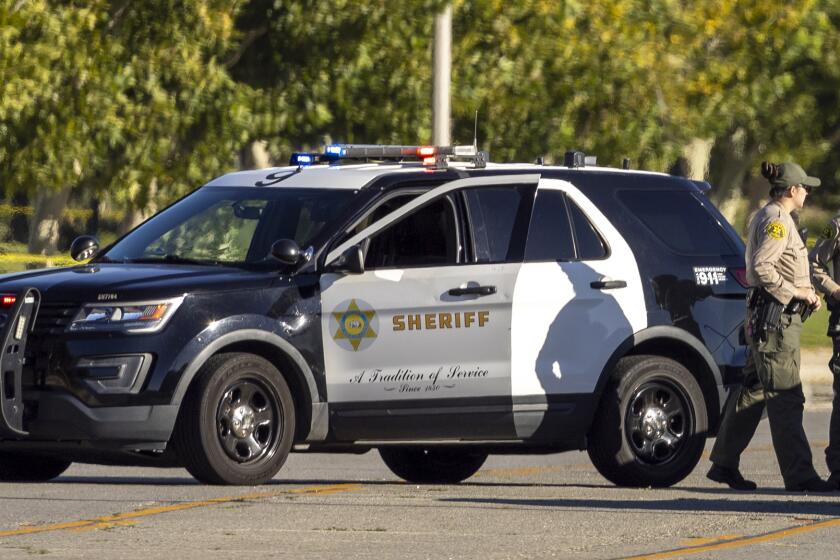Old Guns, Few Troops Left San Diego Poorly Prepared for an Invasion : Defense: Had the Japanese tried to attack, they would have met little resistance along the coast.
- Share via
One commissioned officer, 18 soldiers and a dog named Bozo were responsible for defending San Diego’s coast at Fort Rosecrans in 1935. Six years later, when the Japanese bombed Pearl Harbor, San Diego’s coastal defenders were greater in number but scarcely more ready.
Within the county, several thousand troops were poised at the north and at the south to protect against inland invaders. But shoddy equipment left the coast largely unprotected--U.S. troops struggled with antiquated, unwieldy guns that were difficult to aim and unreliable to fire. Had the Japanese attacked the San Diego coast, they would have met with little resistance, military experts say.
“Would our guns have been any defense against Japanese Zeros (fighter planes)? Absolutely not,” said Howard B. Overton, chief ranger at Cabrillo National Monument and editor of the soon-to-be-published “Guns of Point Loma.”
“We had all kinds of guns but they weren’t going to be effective. If the Japanese had attacked, we were simply not prepared,” he said.
The Japanese bombing of the Hawaiian base on Dec. 7, 1941, killed 2,403 Americans and ushered the United States into World War II. Hawaii and the U.S. Pacific Fleet had always loomed as the first--and what had seemed impenetrable--line of defense.
The bombing of Pearl Harbor left San Diegans feeling vulnerable and ill-prepared as they girded for what seemed like an inevitable attack.
The region’s senior military official, Rear Adm. Charles A. Blakely, the commandant of the 11th district, was recuperating in the Naval Hospital from a heart attack. On his staff were only 10 officers above the rank of lieutenant junior grade who were not either retired or in the Naval Reserve.
That afternoon, the city’s most aggressive defense ploy was to pull a net across the harbor to keep out enemy submarines--a scheme that had failed elsewhere as enemy submarine commanders learned to scoot into a harbor on the stern of an unknowing ship. And in the weeks following Pearl Harbor, the Navy stationed barrage balloons across San Diego, hoping they would discourage enemy planes from flying too low and risk getting entangled in the lines that tethered them to the ground.
Soldiers here began an around-the-clock watch, with special patrols set up to guard the city’s water, telephone, power and railroad systems. At Fort Rosecrans, commanded by the Army, the guns and lookouts were manned 24 hours a day for the next six months. Fog, in these days before radar, only made their task more unnerving.
Fort Rosecrans--which sits atop Point Loma, overlooking San Diego harbor as well as the coast--served as the linchpin in the county’s coastal defense. Though its location was strategic, the fort’s old guns could only have been considered modern in 1898, according to military historians.
Two batteries, installed in 1919, sported 12-inch mortars--technology hailing from the Civil War--that were slow in firing and would have been demolished by any ship larger than a destroyer. Some batteries couldn’t shoot far enough; others were unable to reliably fire upon a moving target.
Worse yet, when war broke out, “the authorities suddenly realized that Batteries Wilkeson and Calef couldn’t actually depress their muzzles enough to fire at any ship entering San Diego harbor but were actually pointed directly at National City and the Silver Strand south of Coronado,” according to an account by a gun crew member.
And the batteries were anything but easy to operate. The guns required two crews: one team actually fired the gun and the second calculated the trajectory to reach the target. Using crude equipment, this second team plotted such variables as wind, rotation of the earth, temperature and humidity, drift of the projectile as well as speed and intended course of the target. They also had to allow for the time delay inherent in transmitting the information by field telephone.
“Accuracy wasn’t necessarily expected or even desired,” recalled gun crew member Hollis T. Gillespie. On the third round, “if it went over or somewhere close (to the target), then it was generously assumed that the gun crew would have certainly hit a much larger profile of an enemy ship and the gun pointer probably courteously missed on purpose rather than destroy the target and thus delay, or even completely prevent the next gun crew’s opportunity to fire.”
More to Read
Sign up for Essential California
The most important California stories and recommendations in your inbox every morning.
You may occasionally receive promotional content from the Los Angeles Times.













